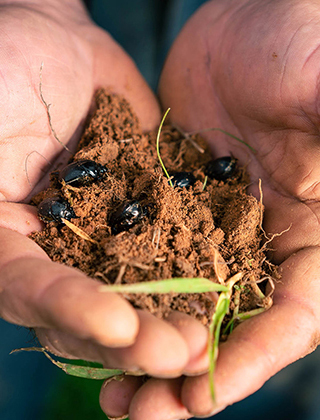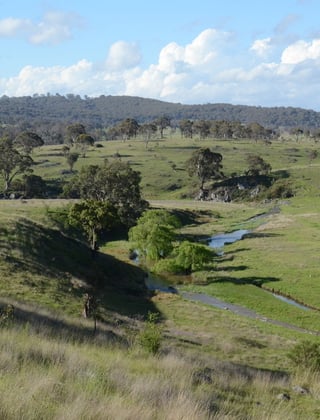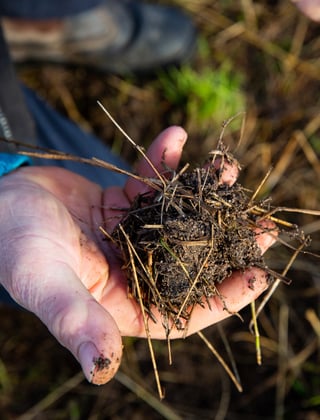Are you sowing hardseeded legume-based pastures this autumn?

A collaborative project has been examining how hardseeded legumes can be used to increase the supply of feed in modern mixed farming systems in southern Australia and therefore increase the productivity of livestock.
A collaborative project has been examining how hardseeded legumes can be used to increase the supply of feed in modern mixed farming systems in southern Australia and therefore increase the productivity of livestock.
Key points
- Hardseeded legumes produced more feed and seed than traditional legumes across a range of soil and seasonal conditions including extreme drought.
- Hardseeded legumes offer more flexible pasture-crop rotations enabling growers more flexibility in their livestock and crop enterprises.
- Adequate preparation is the key to success of any pasture renovation program.
The Dryland Legume Pasture System (DLPS) project, which commenced in 2018, has been investigating the use of hardseeded legumes such as arrowleaf clover, biserrula, bladder clover, gland clover, French serradella and yellow serradella in pasture-crop rotations.
A key component of the research has been to evaluate how hardseeded legumes might be able to be integrated into farming systems to increase productivity of livestock.
The project has encountered years of extreme drought through to seasons where rainfall has been up to 50% above the long-term average across a range of soil types. Throughout, hardseeded legumes have been shown to be well-adapted to the climatic and soil challenges facing modern mixed farming systems in southern Australia.
The DLPS project is jointly funded by the Rural Research and Development for Profit program, AWI, GRDC and MLA in collaboration with Murdoch University, the Department of Primary Industries and Regional Development (DPIRD), NSW Department of Primary Industries (DPI), CSIRO, the South Australian Research and Development Institute (SARDI) and Charles Sturt University.
How do hardseeded legumes differ from traditional legumes like subterranean clover and annual medics?
In the mixed farming zone, pastures are grown in rotation with crops with the pastures needing to be resown after the cropping phases. Transitioning between the crop and pasture phase can be slow. Usually, it takes considerable time to establish new sowings with a requirement for lenient grazing to ensure adequate seed is produced for future paddock regeneration.
Furthermore, over the last 20-30 years, traditional legume species such as subterranean clover and annual medics have often exhibited poor production and persistence, and this has put many producers off re-establishing traditional legume pastures. Changing climatic conditions resulting in unreliable seed production and/or losses of regenerating plants due to false breaks in late summer and early autumn have challenged traditional legumes. Additionally, seed costs are high due to the laborious nature of harvesting seed which requires the use of a suction clover harvester and further seed processing.
The hardseeded annual legumes discussed in this article have attributes that fit well with modern farming systems and their inherent soil and climatic challenges. They can be harvested using a conventional header providing cheap seed, allowing producers to grow seed on-farm which they can then harvest and then sow themselves. Header harvesting also minimises soil disturbance. This contrasts with suction harvesting of traditional legumes which destroys soil surface structure and increases erosion risk.
Additionally, hardseeded legumes lack burrs and spines and do not present a wool contamination risk where traditional legumes do.
Hardseeded legumes have deep root systems reaching 1.3-1.8 m (see Table 1) compared to 90 cm for subterranean clover and annual medics, providing improved drought tolerance and greater resilience under poor seasonal conditions, leading to more reliable seed production. These legumes also have 45-90% of seed produced remaining hard by the following autumn compared to less than 30% for most subterranean clovers. Higher amounts of hard seed give greater protection against false breaks.
High levels of residual hard seed allow paddocks to be cropped over with the pasture legume then being able to regenerate without the need for re-sowing. For very hardseeded legume cultivars of biserrula and yellow serradella, with high previous seed set, paddocks can be cropped for 3-5 years with legumes regenerating without needing to re-sow. For arrowleaf clover, bladder clover, gland clover and hardseeded cultivars of French serradella, rotations of one-year crop, one-year pasture work well, although occasional cropping phases of two-years duration can be imposed where the legume has set seed on a number of occasions.
Having a large, robust legume seed bank means that producers can switch their paddocks between crop and pasture production very quickly. This is a very useful attribute that allows growers to take advantage of changing commodity prices and/or seasonal conditions.
Species suitability to soils and climatic conditions
Hardseeded legumes and their rhizobia vary in their suitability to differing soils (see Table 1). All hardseeded legumes in this article have superior tolerance to drought conditions compared to traditional legumes. In NSW, under extreme drought in 2019, the hardseeded legumes produced an average of 4 t DM/ha compared to less than 0.5 t DM/ha for traditional legumes where rainfall was less than half the long-term average. All produced adequate seed, resulting in the formation of a robust seedbank for the following years, while subterranean clover did not. On the neutral/alkaline sandy loams of SA and Victoria, annual medics have continued to perform well.
Capacity to produce 4 t DM/ha under severe drought conditions provides opportunity to maintain breeding flocks, finish animals and build soil fertility. Wheat grain yield at Ungarie in NSW following legumes in 2020 were greater than 3.8 t/ha without adding nitrogen fertiliser. In contrast, subterranean clover and annual medic plots needed application of nitrogen at sowing and again at tillering to achieve the same grain yield. Further, in Ardath and Mingenew in WA, wheat grown over French serradella plots with minimal nitrogen applied resulted in higher yields and proteins than the control. Following a good medic pasture in SA and Victoria, wheat grain yield increased by 1.1 t/ha compared to a continuous cereal treatment.

Factors to consider when sowing pastures containing hardseeded legumes
Paddock preparation
Weed control prior to sowing is paramount. Weed competition is the leading factor contributing to pasture establishment failure. A minimum of two, but preferably three, years of stringent weed control leading into pasture sowing should be undertaken.
Check for potential for herbicide residue damage prior to sowing a new pasture. Factors that can influence herbicide breakdown and hence plant-back requirements include time elapsed since application, rainfall received since application, soil moisture conditions, soil pH, soil texture and the initial application rate. Make sure to abide by all label requirements and, if in any doubt, seek advice.
Seed form and sowing time
When sowing pasture legumes in autumn, you will almost invariably be purchasing seed that has been scarified. Scarification means that the seed has been processed to achieve a high levels of germination following sowing (generally greater than 90%). When sowing scarified seed, it is advisable to wait for the first autumn rains and then apply a knockdown to control weeds. The earlier in autumn the opening season rains occur followed by application of a knockdown and then sowing of the legume, the higher the production that can be expected to be achieved.
The legumes discussed in this article have capacity to form deep root systems quickly and are better at withstanding warmer and drier conditions in autumn compared to traditional shallow-rooted legumes. This is particularly so for biserrula and serradella which are highly resilient plants.
Sowing rate and depth
For establishment of monoculture legumes by autumn sowing of scarified seed, seeding rates of 5-10 kg/ha are suggested. Seed of these legumes are very small. For optimal establishment, sow at a depth not exceeding 10mm. Burial below this depth will result in decline in emergence.
Inoculants
It is critical when sowing any legume that an inoculant is used that contains the correct rhizobia for that particular legume (see Table 1). If using peat inoculant, make sure treated seed is sown within 12 hours and that there is reasonable soil moisture for rhizobia survival. Granular inoculants have been developed more recently and are convenient to use and some offer greater capacity for rhizobia survival if sowing into dry soil.
Management in the establishment year
The main goal in the establishment year is achieving adequate seed set for future regeneration. Carefully monitor the newly sown pasture for signs of pests and disease. Should these be encountered, take appropriate action to control them.
Where weed issues are observed in newly established pastures, it is important to instigate control early while the weeds are small. The tolerances of hardseeded legumes to herbicides can vary considerably from subterranean clover and annual medics and it is important to seek advice on herbicides that can be safely used and are registered for the purpose.
In some situations, other weed control options may be appropriate. For example, grazing has been a very effective means of controlling many weeds including annual ryegrass, wild radish and capeweed in biserrula due to differences in palatability. Weed wipers have also proven to be very effective in controlling weeds later in the growing season that sit above the pasture canopy and where grazing has been used to reduce pasture height below that of the target weeds.
Still not sure what to sow? Some additional tips
A strategy that has worked very well for growers deciding on which hardseeded legume to sow has been to grow small areas (5-20 ha) of a range of legume species in blocks within a paddock. If you’ve not grown any of these legumes before, it can be a very effective way to reduce the outlay required in seed purchase and allow you to evaluate a number of species under your farm conditions.
Additionally, growers then have the option to harvest these areas and obtain their own unprocessed seed which can then be used to sow other areas of the farm using establishment options such as summer and twin sowing.
More information: www.wool.com/legumes
Dr Belinda Hackney, NSW DPI
belinda.hackney@dpi.nsw.gov.au
Robert Harrison, CSIRO
robert.harrison@csiro.au
Dr Ron Yates, DPIRD WA and Murdoch University
ronald.yates@dpird.wa.gov.au
David Peck, SARDI
david.peck@sa.gov.au
This article appeared in the March 2022 edition of AWI’s Beyond the Bale magazine. Reproduction of the article is encouraged.





















